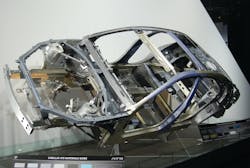University of Extrication: New-Design A- and B-Pillars
This University of Extrication Trainer’s Guide addresses a new challenge that is arising from design changes of the newest model vehicles being produced today. Manufacturers are increasingly re-designing the structure of their new model-year vehicles to be lightweight for fuel efficiency and strong to be crashworthy at the same time. The structure is referred to by engineers as the “architecture” of the vehicle; what we might call the “skeletal system.” One new challenge for rescue personnel that has arisen out of this trend is the presence of advanced steels such as Boron and Martensite. Almost every 2012 model-year vehicle uses one (or more) variety of advanced steels in its structure at multiple locations. The second significant challenge that goes right along with the use of advanced steels stems from the new designs of the architecture: changes in the design of the lower areas of the A and B pillars.
There is a trend by design engineers to create A pillars and B pillars that have significantly larger, longer and wider lower sections where the pillars join to the rocker of the vehicle. The challenge that a wider base on the A pillar presents comes into play when rescue personnel work to complete a dash jacking or dash rolling evolution. The new, wider base design to the B pillar, sort of a pyramid design, will cause difficulty when working to lay the B pillar out or when totally removing the side of a crash-damaged vehicle.
In other words, for B-pillar removal or total side removal: we would typically make only one cut in the back side of a B pillar and then tear it off the car with our spreader; we may not be able to do that now on these new cars with their new structural design. Where we are used to making one cut in the back side of the base of the A pillar in order to roll the dash or jack the dash, we will now also have to modify this process by making additional cuts into and around the base of the A pillar.
While conducting dash evolutions or B-pillar removal training on older vehicles, we should now include consideration for making additional cuts. If one considers the base of the A or B pillar as a “box” in this new architecture design, then we must train to cut completely through the back side of the pillar, the outside metal of the pillar, the inside edge of the pillar, as well as even the front portion of the pillar’s box. If in the Real World, we encounter a new-model vehicle with advanced steel such as Boron all around its base, then one cut like we are used to may not be sufficient enough to tear the pillar off the vehicle or allow the dash and instrument panel to be jacked or rolled. Cut the whole box; all four sides to be assured the best success.
TASK: The rescue team shall be assigned to complete 1) dash rolling, 2) dash jacking, and 3) B-pillar side-removal evolutions on an older, acquired vehicle and must integrate multiple pillar cuts on all sides of the base of the pillars to simulate the challenges of working on a new-design A- or B-pillar vehicle.
